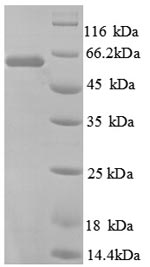Recombinant Human RNA-binding protein RO60 is expressed in E. coli with an N-terminal 6xHis-tag, covering the 3-535 amino acid region. This partial protein is produced with purity exceeding 90%, as verified by SDS-PAGE analysis. It is intended for research use only and is not suitable for therapeutic or diagnostic applications.
The RO60 protein appears to be a key component in cellular machinery, particularly known for its role in RNA binding and processing. It seems to be involved in stabilizing cellular RNA molecules and has become a subject of interest in studies focusing on RNA metabolism and autoimmune responses. Researchers rely on RO60 to explore its functions and interactions within various cellular pathways, though the complete picture of its role may be more complex than initially understood.
Potential Applications
Note: The applications listed below are based on what we know about this protein's biological functions, published research, and experience from experts in the field. However, we haven't fully tested all of these applications ourselves yet. We'd recommend running some preliminary tests first to make sure they work for your specific research goals.
Based on the provided information, the recombinant human RO60 protein is expressed in E. coli, a prokaryotic system that is generally unsuitable for producing properly folded eukaryotic RNA-binding proteins. RO60 requires precise folding for its RNA-binding activity and interaction with other cellular components. The recombinant RO60 protein is expressed as a near-full-length fragment (3-535aa, missing only the first 2 amino acids) with an N-terminal 6xHis tag. While the length covers almost the entire protein and purity is >90%, E. coli lacks the eukaryotic chaperones and post-translational modification machinery necessary for the correct folding of complex RNA-binding proteins. Since activity is unverified, the protein cannot be assumed to be correctly folded or bioactive without experimental validation of its RNA-binding capability and proper conformation.
1. Protein-Protein Interaction Studies Using His-Tag Pull-Down Assays
The N-terminal 6xHis tag enables technical feasibility for pull-down assays. However, if RO60 is misfolded (as is likely in E. coli), it may not interact physiologically with true binding partners. RNA-binding proteins require specific conformations for proper interactions. Identified interactions could be non-physiological artifacts. This application should only be pursued after confirming proper folding through biophysical characterization.
2. Antibody Development and Validation
This application is appropriate as the safest use case. The near-full-length RO60 can serve as an effective immunogen for generating antibodies that recognize linear epitopes. The high purity and substantial coverage (3-535aa) support antibody production. However, if misfolded, antibodies may not recognize conformational epitopes of native RO60. Validation against endogenous RO60 is recommended.
3. Biochemical Characterization and Biophysical Analysis
This application is well-suited and should be prioritized. Techniques like size-exclusion chromatography, dynamic light scattering, and circular dichroism can directly assess the protein's folding state, oligomerization, and stability. These studies are valuable even if the protein is inactive, as they characterize the recombinant product itself.
4. His-Tag Based ELISA Development
This application is feasible for detection but has limitations. The His-tag enables technical development of ELISA assays. However, if RO60 is misfolded, quantitative measurements may not correlate with native protein function. The assay may work for detection, but requires validation against properly folded RO60 for accurate quantification.
Final Recommendation & Action Plan
Given the uncertainty in folding and bioactivity, recommend first performing a comprehensive biophysical characterization to assess folding quality. This should include circular dichroism spectroscopy for secondary structure analysis and size-exclusion chromatography with multi-angle light scattering for oligomeric state assessment. Antibody development can proceed immediately as the lowest-risk application. Protein interaction studies and quantitative assays should await proper folding validation. For reliable RO60 functional studies, consider obtaining the protein from eukaryotic expression systems capable of proper folding. Always include appropriate controls, such as known RNA substrates, when possible.






